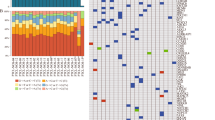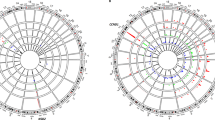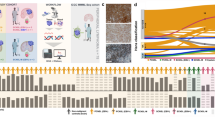Abstract
To decipher the mutational pattern of primary CNS lymphoma (PCNSL), we performed whole-exome sequencing to a median coverage of 103 × followed by mutation verification in 9 PCNSL and validation using Sanger sequencing in 22 PCNSL. We identified a median of 202 (range: 139–251) potentially somatic single nucleotide variants (SNV) and 14 small indels (range: 7–22) with potentially protein-changing features per PCNSL. Mutations affected the B-cell receptor, toll-like receptor, and NF-κB and genes involved in chromatin structure and modifications, cell-cycle regulation, and immune recognition. A median of 22.2% (range: 20.0–24.7%) of somatic SNVs in 9 PCNSL overlaps with the RGYW motif targeted by somatic hypermutation (SHM); a median of 7.9% (range: 6.2–12.6%) affects its hotspot position suggesting a major impact of SHM on PCNSL pathogenesis. In addition to the well-known targets of aberrant SHM (aSHM) (PIM1), our data suggest new targets of aSHM (KLHL14, OSBPL10, and SUSD2). Among the four most frequently mutated genes was ODZ4 showing protein-changing mutations in 4/9 PCNSL. Together with mutations affecting CSMD2, CSMD3, and PTPRD, these findings may suggest that alterations in genes having a role in CNS development may facilitate diffuse large B-cell lymphoma manifestation in the CNS. This may point to intriguing mechanisms of CNS tropism in PCNSL.
This is a preview of subscription content, access via your institution
Access options
Subscribe to this journal
Receive 12 print issues and online access
$259.00 per year
only $21.58 per issue
Buy this article
- Purchase on Springer Link
- Instant access to full article PDF
Prices may be subject to local taxes which are calculated during checkout






Similar content being viewed by others
References
Deckert M, Engert A, Brück W, Ferreri AJ, Finke J, Illerhaus G et al. Modern concepts in the biology, diagnosis, differential diagnosis and treatment of primary central nervous system lymphoma. Leukemia 2011; 25: 1797–1807.
Deckert M, Montesinos-Rongen M, Brunn A, Siebert R . Systems biology of primary CNS lymphoma: from genetic aberrations to modeling in mice. Acta Neuropathol 2014; 127: 175–188.
Montesinos-Rongen M, Siebert R, Deckert M . Primary lymphoma of the central nervous system: just DLBCL or not? Blood 2009; 113: 7–10.
Montesinos-Rongen M, Brunn A, Bentink S, Basso K, Lim WK, Klapper W et al. Gene expression profiling suggests primary central nervous system lymphomas to be derived from a late germinal center B cell. Leukemia 2008; 22: 400–405.
Cady FM, O'Neill BP, Law ME, Decker PA, Kurtz DM, Giannini C et al. Del(6)(q22) and BCL6 rearrangements in primary CNS lymphoma are indicators of an aggressive clinical course. J Clin Oncol 2008; 26: 4814–4819.
Montesinos-Rongen M, Akasaka T, Zühlke-Jenisch R, Schaller C, Van Roost D, Wiestler OD et al. Molecular characterization of BCL6 breakpoints in primary diffuse large B-cell lymphomas of the central nervous system identifies GAPD as novel translocation partner. Brain Pathol 2003; 13: 534–538.
Montesinos-Rongen M, Zühlke-Jenisch R, Gesk S, Martin-Subero JI, Schaller C, Van Roost D et al. Interphase cytogenetic analysis of lymphoma-associated chromosomal breakpoints in primary diffuse large B-cell lymphomas of the central nervous system. J Neuropathol Exp Neurol 2002; 61: 926–933.
Montesinos-Rongen M, Schmitz R, Courts C, Stenzel W, Bechtel D, Niedobitek G et al. Absence of immunoglobulin class switch in primary lymphomas of the central nervous system. Am J Pathol 2005; 166: 1773–1779.
Courts C, Montesinos-Rongen M, Brunn A, Bug S, Siemer D, Hans V et al. Recurrent inactivation of the PRDM1 gene in primary central nervous system lymphoma. J Neuropathol Exp Neurol 2008; 67: 720–727.
Montesinos-Rongen M, Küppers R, Schlüter D, Spieker T, Van Roost D, Schaller C et al. Primary central nervous system lymphomas are derived from germinal-center B cells and show a preferential usage of the V4-34 gene segment. Am J Pathol 1999; 155: 2077–2086.
Thompsett AR, Ellison DW, Stevenson FK, Zhu D . V(H) gene sequences from primary central nervous system lymphomas indicate derivation from highly mutated germinal center B cells with ongoing mutational activity. Blood 1999; 94: 1738–1746.
Montesinos-Rongen M, Van Roost D, Schaller C, Wiestler OD, Deckert M . Primary diffuse large B-cell lymphomas of the central nervous system are targeted by aberrant somatic hypermutation. Blood 2004; 103: 1869–1875.
Montesinos-Rongen M, Schäfer E, Siebert R, Deckert M . Genes regulating the B cell receptor pathway are recurrently mutated in primary central nervous system lymphoma. Acta Neuropathol 2012; 124: 905–906.
Montesinos-Rongen M, Godlewska E, Brunn A, Wiestler OD, Siebert R, Deckert M . Activating L265P mutations of the MYD88 gene are common in primary central nervous system lymphoma. Acta Neuropathol 2011; 122: 791–792.
Montesinos-Rongen M, Schmitz R, Brunn A, Gesk S, Richter J, Hong K et al. Mutations of CARD11 but not TNFAIP3 may activate the NF-kappaB pathway in primary CNS lymphoma. Acta Neuropathol 2010; 120: 529–535.
Schwindt H, Vater I, Kreuz M, Montesinos-Rongen M, Brunn A, Richter J et al. Chromosomal imbalances and partial uniparental disomies in primary central nervous system lymphoma. Leukemia 2009; 23: 1875–1884.
Courts C, Montesinos-Rongen M, Martin-Subero JI, Brunn A, Siemer D, Zühlke-Jenisch R et al. Transcriptional profiling of the nuclear factor-kappaB pathway identifies a subgroup of primary lymphoma of the central nervous system with low BCL10 expression. J Neuropathol Exp Neurol 2007; 66: 230–237.
Gonzalez-Aguilar A, Idbaih A, Boisselier B, Habbita N, Rossetto M, Laurenge A et al. Recurrent mutations of MYD88 and TBL1XR1 in primary central nervous system lymphomas. Clin Cancer Res 2012; 18: 5203–5211.
Riemersma SA, Jordanova ES, Schop RF, Philippo K, Looijenga LH, Schuuring E et al. Extensive genetic alterations of the HLA region, including homozygous deletions of HLA class II genes in B-cell lymphomas arising in immune-privileged sites. Blood 2000; 96: 3569–3577.
Rubenstein JL, Fridlyand J, Shen A, Aldape K, Ginzinger D, Batchelor T et al. Gene expression and angiotropism in primary CNS lymphoma. Blood 2006; 107: 3716–3723.
Tun HW, Personett D, Baskerville KA, Menke DM, Jaeckle KA, Kreinest P et al. Pathway analysis of primary central nervous system lymphoma. Blood 2008; 111: 3200–3210.
Alizadeh AA, Eisen MB, Davis RE, Ma C, Lossos IS, Rosenwald A et al. Distinct types of diffuse large B-cell lymphoma identified by gene expression profiling. Nature 2000; 403: 503–511.
Jima DD, Zhang J, Jacobs C, Richards KL, Dunphy CH, Choi WW et al. Deep sequencing of the small RNA transcriptome of normal and malignant human B cells identifies hundreds of novel microRNAs. Blood 2010; 116: e118–e127.
Lohr JG, Stojanov P, Lawrence MS, Auclair D, Chapuy B, Sougnez C et al. Discovery and prioritization of somatic mutations in diffuse large B-cell lymphoma (DLBCL) by whole-exome sequencing. Proc Natl Acad Sci USA 2012; 109: 3879–3884.
Morin RD, Mendez-Lago M, Mungall AJ, Goya R, Mungall KL, Corbett RD et al. Frequent mutation of histone-modifying genes in non-Hodgkin lymphoma. Nature 2011; 476: 298–303.
Morin RD, Mungall K, Pleasance E, Mungall AJ, Goya R, Huff RD et al. Mutational and structural analysis of diffuse large B-cell lymphoma using whole-genome sequencing. Blood 2013; 122: 1256–1265.
Pasqualucci L, Trifonov V, Fabbri G, Ma J, Rossi D, Chiarenza A et al. Analysis of the coding genome of diffuse large B-cell lymphoma. Nat Genet 2011; 43: 830–837.
Alexandrov LB, Nik-Zainal S, Wedge DC, Aparicio SA, Behjati S, Biankin AV et al. Signatures of mutational processes in human cancer. Nature 2013; 500: 415–421.
Deckert M, Paulus W . Malignant Lymphomas. In: Louis DN, Ohgaki H, Wiestler OD, Cavenee WK (eds) WHO Classification of Tumors Pathology & Genetics of Tumours of the Nervous System4th edn.IRAC: Lyon, 2007; pp 188–192.
Jones DT, Hutter B, Jager N, Korshunov A, Kool M, Warnatz HJ et al. Recurrent somatic alterations of FGFR1 and NTRK2 in pilocytic astrocytoma. Nat Genet 2013; 45: 927–932.
Li H, Durbin R . Fast and accurate short read alignment with Burrows–Wheeler transform. Bioinformatics 2009; 25: 1754–1760.
Li H, Handsaker B, Wysoker A, Fennell T, Ruan J, Homer N et al. The Sequence Alignment/Map format and SAMtools. Bioinformatics 2009; 25: 2078–2079.
Rimmer A, Mathieson I, Lunter G, McVean G . Platypus: An Integrated Variant Caller 2012 [cited 2014 January 25, 2014]; Available from www.well.ox.ac.uk/platypus.
Wang K, Li M, Hakonarson H . ANNOVAR: functional annotation of genetic variants from high-throughput sequencing data. Nucleic Acids Res 2010; 38: e164.
Hansen RS, Thomas S, Sandstrom R, Canfield TK, Thurman RE, Weaver M et al. Sequencing newly replicated DNA reveals widespread plasticity in human replication timing. Proc Natl Acad Sci USA 2010; 107: 139–144.
Floratos A, Smith K, Ji Z, Watkinson J, Califano A . geWorkbench: an open source platform for integrative genomics. Bioinformatics 2010; 26: 1779–1780.
Brunn A, Nagel I, Montesinos-Rongen M, Klapper W, Vater I, Paulus W et al. Frequent triple-hit expression of MYC, BCL2, and BCL6 in primary lymphoma of the central nervous system and absence of a favorable MYC(low)BCL2 (low) subgroup may underlie the inferior prognosis as compared to systemic diffuse large B cell lymphomas. Acta Neuropathol 2013; 126: 603–605.
Fontebasso AM, Schwartzentruber J, Khuong-Quang DA, Liu XY, Sturm D, Korshunov A et al. Mutations in SETD2 and genes affecting histone H3K36 methylation target hemispheric high-grade gliomas. Acta Neuropathol 2013; 125: 659–669.
Pasqualucci L, Neumeister P, Goossens T, Nanjangud G, Chaganti RS, Kuppers R et al. Hypermutation of multiple proto-oncogenes in B-cell diffuse large-cell lymphomas. Nature 2001; 412: 341–346.
Sima J, Gilbert DM . Complex correlations: replication timing and mutational landscapes during cancer and genome evolution. Curr Opin Genet Dev 2014; 25C: 93–100.
Bruno A, Boisselier B, Labreche K, Marie Y, Polivka M, Jouvet A et al. Mutational analysis of primary central nervous system lymphoma. Oncotarget 2014; 5: 5065–5075.
Braggio E, McPhail ER, Macon W, Lopes MB, Schiff D, Law M et al. Primary central nervous system lymphomas: a validation study of array-based comparative genomic hybridization in formalin-fixed paraffin-embedded tumor specimens. Clin Cancer Res 2011; 17: 4245–4253.
Sung CO, Kim SC, 3569- S, Karube K, Shin HJ, Nam DH et al. Genomic profiling combined with gene expression profiling in primary central nervous system lymphoma. Blood 2011; 117: 1291–1300.
Mottok A, Renne C, Seifert M, Oppermann E, Bechstein W, Hansmann ML et al. Inactivating SOCS1 mutations are caused by aberrant somatic hypermutation and restricted to a subset of B-cell lymphoma entities. Blood 2009; 114: 4503–4506.
Brunn A, Utermöhlen O, Mihelcic M, Sanchez-Ruiz M, Carstov M, Blau T et al. Differential effects of CXCR4-CXCL12- and CXCR7-CXCL12-mediated immune reactions on murine P0106-125 -induced experimental autoimmune neuritis. Neuropathol Appl Neurobiol 2013; 39: 772–787.
Horn H, Ziepert M, Becher C, Barth TFE, Bernd H-W, Feller AC et al. MYC status in concert with BCL2 and BCL6 expression predicts outcome in diffuse large B-cell lymphoma. Blood 2013; 121: 2253–2263.
Johnson NA, Slack GW, Savage KJ, Connors JM, Ben-Neriah S, Rogic S et al. Concurrent expression of MYC and BCL2 in diffuse large B-cell lymphoma treated with rituximab plus cyclophosphamide, doxorubicin, vincristine, and prednisone. J Clin Oncol 2012; 30: 3452–3459.
Davis RE, Ngo VN, Lenz G, Tolar P, Young RM, Romesser PB et al. Chronic active B-cell-receptor signalling in diffuse large B-cell lymphoma. Nature 2010; 463: 88–92.
Booman M, Douwes J, Glas AM, Riemersma SA, Jordanova ES, Kok K et al. Mechanisms and effects of loss of human leukocyte antigen class II expression in immune-privileged site-associated B-cell lymphoma. Clin Cancer Res 2006; 12: 2698–2705.
Booman M, Szuhai K, Rosenwald A, Hartmann E, Kluin-Nelemans H, de Jong D et al. Genomic alterations and gene expression in primary diffuse large B-cell lymphomas of immune-privileged sites: the importance of apoptosis and immunomodulatory pathways. J Pathol 2008; 216: 209–217.
Jordanova ES, Philippo K, Giphart MJ, Schuuring E, Kluin PM . Mutations in the HLA class II genes leading to loss of expression of HLA-DR and HLA-DQ in diffuse large B-cell lymphoma. Immunogenetics 2003; 55: 203–209.
Kenzelmann-Broz D, Tucker RP, Leachman NT, Chiquet-Ehrismann R . The expression of teneurin-4 in the avian embryo: potential roles in patterning of the limb and nervous system. Int J Dev Biol 2010; 54: 1509–1516.
Suzuki N, Fukushi M, Kosaki K, Doyle AD, de Vega S, Yoshizaki K et al. Teneurin-4 is a novel regulator of oligodendrocyte differentiation and myelination of small-diameter axons in the CNS. J Neurosci 2012; 32: 11586–11599.
Psychiatric GCBDWG. Large-scale genome-wide association analysis of bipolar disorder identifies a new susceptibility locus near ODZ4. Nat Genet 2011; 43: 977–983.
Arregui CO, Balsamo J, Lilien J . Regulation of signaling by protein-tyrosine phosphatases: potential roles in the nervous system. Neurochem Res 2000; 25: 95–105.
Sun QL, Wang J, Bookman RJ, Bixby JL . Growth cone steering by receptor tyrosine phosphatase delta defines a distinct class of guidance cue. Mol Cell Neurosci 2000; 16: 686–695.
Boeva V, Jouannet S, Daveau R, Combaret V, Pierre-Eugène C, Cazes A et al. Breakpoint features of genomic rearrangements in neuroblastoma with unbalanced translocations and chromothripsis. PLoS One 2013; 8: e72182.
Molenaar JJ, Koster J, Zwijnenburg DA, van Sluis P, Valentijn LJ, van der Ploeg I et al. Sequencing of neuroblastoma identifies chromothripsis and defects in neuritogenesis genes. Nature 2012; 483: 589–593.
Shimizu A, Asakawa S, Sasaki T, Yamazaki S, Yamagata H, Kudoh J et al. A novel giant gene CSMD3 encoding a protein with CUB and sushi multiple domains: a candidate gene for benign adult familial myoclonic epilepsy on human chromosome 8q23.3-q24.1. Biochem Biophys Res Commun 2003; 309: 143–154.
Vinatzer U, Gollinger M, Mullauer L, Raderer M, Chott A, Streubel B . Mucosa-associated lymphoid tissue lymphoma: novel translocations including rearrangements of ODZ2, JMJD2C, and CNN3. Clin Cancer Res 2008; 14: 6426–6431.
Acknowledgements
We thank all our technicians. This study has been supported by the Deutsche Krebshilfe (grant nos. 109471, 109472), ICGC MMML-Seq project/German Ministry for Education and Science (BMBF Grant no. 01KU1002 A-J), and the Jackstädt foundation.
Author information
Authors and Affiliations
Corresponding author
Ethics declarations
Competing interests
The authors declare no conflict of interest.
Additional information
Supplementary Information accompanies this paper on the Leukemia website
Supplementary information
Rights and permissions
About this article
Cite this article
Vater, I., Montesinos-Rongen, M., Schlesner, M. et al. The mutational pattern of primary lymphoma of the central nervous system determined by whole-exome sequencing. Leukemia 29, 677–685 (2015). https://doi.org/10.1038/leu.2014.264
Received:
Revised:
Accepted:
Published:
Issue Date:
DOI: https://doi.org/10.1038/leu.2014.264
This article is cited by
-
Extranodal lymphoma: pathogenesis, diagnosis and treatment
Molecular Biomedicine (2023)
-
Primary central nervous system lymphoma
Nature Reviews Disease Primers (2023)
-
Analysis of the genomic landscape of primary central nervous system lymphoma using whole-genome sequencing in Chinese patients
Frontiers of Medicine (2023)
-
Reciprocal expression of the immune response genes CXCR3 and IFI44L as module hubs are associated with patient survivals in primary central nervous system lymphoma
International Journal of Clinical Oncology (2023)
-
Integrated genetic analyses of immunodeficiency-associated Epstein-Barr virus- (EBV) positive primary CNS lymphomas
Acta Neuropathologica (2023)



